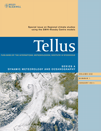 | |
| Discipline | Atmospheric sciences, Oceanography |
|---|---|
| Language | English |
| Edited by | A. Hannachi |
| Publication details | |
| History | 1949-present |
| Publisher | Co-action Publishing on behalf of the International Meteorological Institute |
| Frequency | Bimonthly |
| Yes | |
| License | Creative Commons license |
| 1.700 (2023) | |
| Standard abbreviations | |
| ISO 4 | Tellus A |
| Indexing | |
| CODEN | TSAOD8 |
| ISSN | 0280-6495 (print) 1600-0870 (web) |
| LCCN | 88647609 |
| OCLC no. | 321236831 |
| Links | |
Tellus Series A: Dynamic Meteorology and Oceanography is a peer-reviewed scientific journal that is published by Co-action Publishing on behalf of the International Meteorological Institute in Stockholm, Sweden. Since January 2012, the journal is published open access. [1] Until that time, it had been published as a subscription journal by Blackwell Munksgaard. The journal publishes original articles, short contributions and correspondence encompassing dynamic meteorology, climatology and oceanography, including numerical modelling, synoptic meteorology, weather forecasting, and climate analysis.
Contents
Tellus A is the companion to Tellus Series B: Chemical and Physical Meteorology .